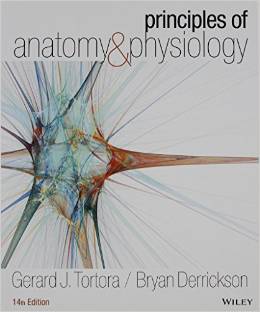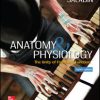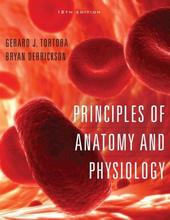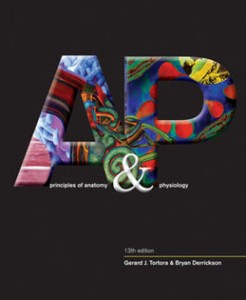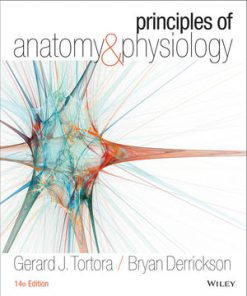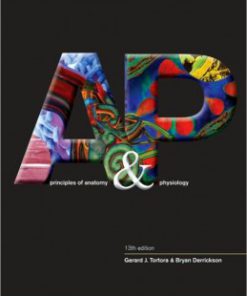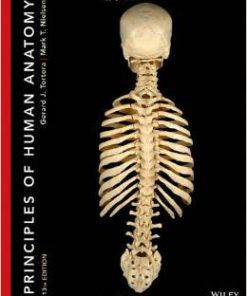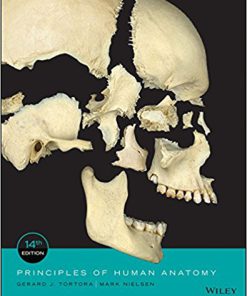Test Bank for Principles of Anatomy and Physiology 14th Edition Gerard J Tortora Download
$35.00 Original price was: $35.00.$26.50Current price is: $26.50.
Test Bank for Principles of Anatomy and Physiology 14th Edition Gerard J Tortora Download
This is completed downloadable of Test Bank for Principles of Anatomy and Physiology 14th Edition Gerard J Tortora Download
Product Details:
- ISBN-10 : 1118344391
- ISBN-13 : 978-1118344392
- Author: Gerard J Tortora
The 14th edition of the phenomenally successful Principles of Anatomy and Physiology continues to set the standard for the discipline. The authors have maintained a superb balance between structure and function and continue to emphasize the correlations between normal physiology and pathophysiology, normal anatomy and pathology, and homeostasis and homeostatic imbalances. No other text and package offers a teaching and learning environment as rich and complete. WileyPLUS sold separately from text.
Table of Content:
- 1 AN INTRODUCTION TO THE HUMAN BODY
- 1.1 Anatomy and Physiology Defined
- 1.2 Levels of Structural Organization and Body Systems
- 1.3 Characteristics of the Living Human Organism
- Basic Life Processes
- 1.4 Homeostasis
- Homeostasis and Body Fluids
- Control of Homeostasis
- Homeostatic Imbalances
- 1.5 Basic Anatomical Terminology
- Body Positions
- Regional Names
- Directional Terms
- Planes and Sections
- Body Cavities
- Abdominopelvic Regions and Quadrants
- 1.6 Medical Imaging
- Chapter Review and Resource Summary
- Critical Thinking Questions
- Answers to Figure Questions
- 2 THE CHEMICAL LEVEL OF ORGANIZATION
- 2.1 How Matter Is Organized
- Chemical Elements
- Structure of Atoms
- Atomic Number and Mass Number
- Atomic Mass
- Ions, Molecules, and Compounds
- 2.2 Chemical Bonds
- Ionic Bonds
- Covalent Bonds
- Hydrogen Bonds
- 2.3 Chemical Reactions
- Forms of Energy and Chemical Reactions
- Energy Transfer in Chemical Reactions
- Types of Chemical Reactions
- 2.4 Inorganic Compounds and Solutions
- Water
- Solutions, Colloids, and Suspensions
- Inorganic Acids, Bases, and Salts
- Acid-Base Balance: The Concept of pH
- Maintaining pH: Buffer Systems
- 2.5 Organic Compounds
- Carbon and Its Functional Groups
- Carbohydrates
- Lipids
- Proteins
- Nucleic Acids: Deoxyribonucleic Acid (DNA) and Ribonucleic Acid (RNA)
- Adenosine Triphosphate
- Chapter Review and Resource Summary
- Critical Thinking Questions
- Answers to Figure Questions
- 3 THE CELLULAR LEVEL OF ORGANIZATION
- 3.1 Parts of a Cell
- 3.2 The Plasma Membrane
- Structure of the Plasma Membrane
- Functions of Membrane Proteins
- Membrane Fluidity
- Membrane Permeability
- Gradients across the Plasma Membrane
- 3.3 Transport across the Plasma Membrane
- Passive Processes
- Active Processes
- 3.4 Cytoplasm
- Cytosol
- Organelles
- 3.5 Nucleus
- 3.6 Protein Synthesis
- Transcription
- Translation
- 3.7 Cell Division
- Somatic Cell Division
- Control of Cell Destiny
- Reproductive Cell Division
- 3.8 Cellular Diversity
- 3.9 Aging and Cells
- Medical Terminology
- Chapter Review and Resource Summary
- Critical Thinking Questions
- Answers to Figure Questions
- 4 THE TISSUE LEVEL OF ORGANIZATION
- 4.1 Types of Tissues
- 4.2 Cell Junctions
- Tight Junctions
- Adherens Junctions
- Desmosomes
- Hemidesmosomes
- Gap Junctions
- 4.3 Comparison between Epithelial and Connective Tissues
- 4.4 Epithelial Tissue
- Classification of Epithelial Tissue
- Covering and Lining Epithelium
- Glandular Epithelium
- 4.5 Connective Tissue
- General Features of Connective Tissue
- Connective Tissue Cells
- Connective Tissue Extracellular Matrix
- Classification of Connective Tissue
- Embryonic Connective Tissue
- Mature Connective Tissue
- 4.6 Membranes
- Epithelial Membranes
- Synovial Membranes
- 4.7 Muscular Tissue
- 4.8 Nervous Tissue
- 4.9 Excitable Cells
- 4.10 Tissue Repair: Restoring Homeostasis
- 4.11 Aging and Tissues
- Medical Terminology
- Chapter Review and Resource Summary
- Critical Thinking Questions
- Answers to Figure Questions
- 5 THE INTEGUMENTARY SYSTEM
- 5.1 Structure of the Skin
- Epidermis
- Keratinization and Growth of the Epidermis
- Dermis
- The Structural Basis of Skin Color
- Tattooing and Body Piercing
- 5.2 Accessory Structures of the Skin
- Hair
- Skin Glands
- Nails
- 5.3 Types of Skin
- 5.4 Functions of the Skin
- Thermoregulation
- Blood Reservoir
- Protection
- Cutaneous Sensations
- Excretion and Absorption
- Synthesis of Vitamin D
- 5.5 Maintaining Homeostasis: Skin Wound Healing
- Epidermal Wound Healing
- Deep Wound Healing
- 5.6 Development of the Integumentary System
- 5.7 Aging and the Integumentary System
- Medical Terminology
- Chapter Review and Resource Summary
- Critical Thinking Questions
- Answers to Figure Questions
- 6 THE SKELETAL SYSTEM: BONE TISSUE
- 6.1 Functions of Bone and the Skeletal System
- 6.2 Structure of Bone
- 6.3 Histology of Bone Tissue
- Compact Bone Tissue
- Spongy Bone Tissue
- 6.4 Blood and Nerve Supply of Bone
- 6.5 Bone Formation
- Initial Bone Formation in an Embryo and Fetus
- Bone Growth during Infancy, Childhood, and Adolescence
- Remodeling of Bone
- Factors Affecting Bone Growth and Bone Remodeling
- 6.6 Fracture and Repair of Bone
- 6.7 Bone’s Role in Calcium Homeostasis
- 6.8 Exercise and Bone Tissue
- 6.9 Aging and Bone Tissue
- Medical Terminology
- Chapter Review and Resource Summary
- Critical Thinking Questions
- Answers to Figure Questions
- 7 THE SKELETAL SYSTEM: THE AXIAL SKELETON
- 7.1 Divisions of the Skeletal System
- 7.2 Types of Bones
- 7.3 Bone Surface Markings
- 7.4 Skull
- General Features and Functions
- Nasal Septum
- Orbits
- Foramina
- Unique Features of the Skull
- 7.5 Hyoid Bone
- 7.6 Vertebral Column
- Normal Curves of the Vertebral Column
- Intervertebral Discs
- Parts of a Typical Vertebra
- Regions of the Vertebral Column
- Age-related Changes in the Vertebral Column
- 7.7 Thorax
- Medical Terminology
- Chapter Review and Resource Summary
- Critical Thinking Questions
- Answers to Figure Questions
- 8 THE SKELETAL SYSTEM: THE APPENDICULAR SKELETON
- 8.1 Pectoral (Shoulder) Girdle
- 8.2 Upper Limb (Extremity)
- 8.3 Pelvic (Hip) Girdle
- 8.4 False and True Pelves
- 8.5 Comparison of Female and Male Pelves
- 8.6 Lower Limb (Extremity)
- 8.7 Development of the Skeletal System
- Medical Terminology
- Chapter Review and Resource Summary
- Critical Thinking Questions
- Answers to Figure Questions
- 9 JOINTS
- 9.1 Joint Classifications
- 9.2 Fibrous Joints
- Sutures
- Syndesmoses
- Interosseous Membranes
- 9.3 Cartilaginous Joints
- Synchondroses
- Symphyses
- 9.4 Synovial Joints
- Structure of Synovial Joints
- Nerve and Blood Supply
- Bursae and Tendon Sheaths
- 9.5 Types of Movements at Synovial Joints
- Gliding
- Angular Movements
- Rotation
- Special Movements
- 9.6 Types of Synovial Joints
- Plane Joints
- Hinge Joints
- Pivot Joints
- Condyloid Joints
- Saddle Joints
- Ball-and-Socket Joints
- 9.7 Factors Affecting Contact and Range of Motion at Synovial Joints
- 9.8 Selected Joints of the Body
- 9.9 Aging and Joints
- 9.10 Arthroplasty
- Hip Replacements
- Knee Replacements
- Medical Terminology
- Chapter Review and Resource Summary
- Critical Thinking Questions
- Answers to Figure Questions
- 10 MUSCULAR TISSUE
- 10.1 Overview of Muscular Tissue
- Types of Muscular Tissue
- Functions of Muscular Tissue
- Properties of Muscular Tissue
- 10.2 Skeletal Muscle Tissue
- Connective Tissue Components
- Nerve and Blood Supply
- Microscopic Anatomy of a Skeletal Muscle Fiber
- Muscle Proteins
- 10.3 Contraction and Relaxation of Skeletal Muscle Fibers
- The Sliding Filament Mechanism
- The Neuromuscular Junction
- 10.4 Muscle Metabolism
- Production of ATP in Muscle Fibers
- Muscle Fatigue
- Oxygen Consumption after Exercise
- 10.5 Control of Muscle Tension
- Motor Units
- Twitch Contraction
- Frequency of Stimulation
- Motor Unit Recruitment
- Muscle Tone
- Isotonic and Isometric Contractions
- 10.6 Types of Skeletal Muscle Fibers
- Slow Oxidative Fibers
- Fast Oxidative-Glycolytic Fibers
- Fast Glycolytic Fibers
- Distribution and Recruitment of Different Types of Fibers
- 10.7 Exercise and Skeletal Muscle Tissue
- Effective Stretching
- Strength Training
- 10.8 Cardiac Muscle Tissue
- 10.9 Smooth Muscle Tissue
- Microscopic Anatomy of Smooth Muscle
- Physiology of Smooth Muscle
- 10.10 Regeneration of Muscular Tissue
- 10.11 Development of Muscle
- 10.12 Aging and Muscular Tissue
- Medical Terminology
- Chapter Review and Resource Summary
- Critical Thinking Questions
- Answers to Figure Questions
- 11 THE MUSCULAR SYSTEM
- 11.1 How Skeletal Muscles Produce Movements
- Muscle Attachment Sites: Origin and Insertion
- Lever Systems and Leverage
- Effects of Fascicle Arrangement
- Coordination among Muscles
- 11.2 How Skeletal Muscles Are Named
- 11.3 Principal Skeletal Muscles
- Medical Terminology
- Chapter Review and Resource Summary
- Critical Thinking Questions
- Answers to Figure Questions
- 12 NERVOUS TISSUE
- 12.1 Overview of the Nervous System
- Organization of the Nervous System
- Functions of the Nervous System
- 12.2 Histology of Nervous Tissue
- Neurons
- Neuroglia
- Myelination
- Collections of Nervous Tissue
- 12.3 Electrical Signals in Neurons
- Ion Channels
- Resting Membrane Potential
- Graded Potentials
- Generation of Action Potentials
- Propagation of Action Potentials
- Encoding of Stimulus Intensity
- Comparison of Electrical Signals Produced by Excitable Cells
- 12.4 Signal Transmission at Synapses
- Electrical Synapses
- Chemical Synapses
- Excitatory and Inhibitory Postsynaptic Potentials
- Structure of Neurotransmitter Receptors
- Removal of Neurotransmitter
- Spatial and Temporal Summation of Postsynaptic Potentials
- 12.5 Neurotransmitters
- Small-Molecule Neurotransmitters
- Neuropeptides
- 12.6 Neural Circuits
- 12.7 Regeneration and Repair of Nervous Tissue
- Neurogenesis in the CNS
- Damage and Repair in the PNS
- Medical Terminology
- Chapter Review and Resource Summary
- Critical Thinking Questions
- Answers to Figure Questions
- 13 THE SPINAL CORD AND SPINAL NERVES
- 13.1 Spinal Cord Anatomy
- Protective Structures
- Vertebral Column
- External Anatomy of the Spinal Cord
- Internal Anatomy of the Spinal Cord
- 13.2 Spinal Nerves
- Connective Tissue Coverings of Spinal Nerves
- Distribution of Spinal Nerves
- Dermatomes
- 13.3 Spinal Cord Physiology
- Sensory and Motor Tracts
- Reflexes and Reflex Arcs
- Medical Terminology
- Chapter Review and Resource Summary
- Critical Thinking Questions
- Answers to Figure Questions
- 14 THE BRAIN AND CRANIAL NERVES
- 14.1 Brain Organization, Protection, and Blood Supply
- Major Parts of the Brain
- Protective Coverings of the Brain
- Brain Blood Flow and the Blood-Brain Barrier
- 14.2 Cerebrospinal Fluid
- Functions of CSF
- Formation of CSF in the Ventricles
- Circulation of CSF
- 14.3 The Brain Stem and Reticular Formation
- Medulla Oblongata
- Pons
- Midbrain
- Reticular Formation
- 14.4 The Cerebellum
- 14.5 The Diencephalon
- Thalamus
- Hypothalamus
- Epithalamus
- Circumventricular Organs
- 14.6 The Cerebrum
- Cerebral Cortex
- Lobes of the Cerebrum
- Cerebral White Matter
- Basal Nuclei
- The Limbic System
- 14.7 Functional Organization of the Cerebral Cortex
- Sensory Areas
- Motor Areas
- Association Areas
- Hemispheric Lateralization
- Brain Waves
- 14.8 Cranial Nerves
- 14.9 Development of the Nervous System
- 14.10 Aging and the Nervous System
- Medical Terminology
- Chapter Review and Resource Summary
- Critical Thinking Questions
- Answers to Figure Questions
- 15 THE AUTONOMIC NERVOUS SYSTEM
- 15.1 Comparison of Somatic and Autonomic Nervous Systems
- Somatic Nervous System
- Autonomic Nervous System
- Comparison of Somatic and Autonomic Motor Neurons
- 15.2 Anatomy of Autonomic Motor Pathways
- Anatomical Components
- Structure of the Sympathetic Division
- Structure of the Parasympathetic Division
- Structure of the Enteric Division
- 15.3 ANS Neurotransmitters and Receptors
- Cholinergic Neurons and Receptors
- Adrenergic Neurons and Receptors
- Receptor Agonists and Antagonists
- 15.4 Physiology of the ANS
- Autonomic Tone
- Sympathetic Responses
- Parasympathetic Responses
- 15.5 Integration and Control of Autonomic Functions
- Autonomic Reflexes
- Autonomic Control by Higher Centers
- Medical Terminology
- Chapter Review and Resource Summary
- Critical Thinking Questions
- Answers to Figure Questions
- 16 SENSORY, MOTOR, AND INTEGRATIVE SYSTEMS
- 16.1 Sensation
- Sensory Modalities
- The Process of Sensation
- Sensory Receptors
- 16.2 Somatic Sensations
- Tactile Sensations
- Thermal Sensations
- Pain Sensations
- Proprioceptive Sensations
- 16.3 Somatic Sensory Pathways
- Posterior Column-Medial Lemniscus Pathway to the Cortex
- Anterolateral Pathway to the Cortex
- Trigeminothalamic Pathway to the Cortex
- Mapping the Primary Somatosensory Area
- Somatic Sensory Pathways to the Cerebellum
- 16.4 Somatic Motor Pathways
- Organization of Upper Motor Neuron Pathways
- Roles of the Basal Nuclei
- Modulation of Movement by the Cerebellum
- 16.5 Integrative Functions of the Cerebrum
- Wakefulness and Sleep
- Learning and Memory
- Medical Terminology
- Chapter Review and Resource Summary
- Critical Thinking Questions
- Answers to Figure Questions
- 17 THE SPECIAL SENSES
- 17.1 Olfaction: Sense of Smell
- Anatomy of Olfactory Receptors
- Physiology of Olfaction
- Odor Thresholds and Adaptation
- The Olfactory Pathway
- 17.2 Gustation: Sense of Taste
- Anatomy of Taste Buds and Papillae
- Physiology of Gustation
- Taste Thresholds and Adaptation
- The Gustatory Pathway
- 17.3 Vision
- Electromagnetic Radiation
- Accessory Structures of the Eye
- Anatomy of the Eyeball
- Image Formation
- Convergence
- Physiology of Vision
- The Visual Pathway
- 17.4 Hearing and Equilibrium
- Anatomy of the Ear
- The Nature of Sound Waves
- Physiology of Hearing
- The Auditory Pathway
- Physiology of Equilibrium
- Equilibrium Pathways
- 17.5 Development of the Eyes and Ears
- Eyes
- Ears
- 17.6 Aging and the Special Senses
- Medical Terminology
- Chapter Review and Resource Summary
- Critical Thinking Questions
- Answers to Figure Questions
- 18 THE ENDOCRINE SYSTEM
- 18.1 Comparison of Control by the Nervous and Endocrine Systems
- 18.2 Endocrine Glands
- 18.3 Hormone Activity
- The Role of Hormone Receptors
- Circulating and Local Hormones
- Chemical Classes of Hormones
- Hormone Transport in the Blood
- 18.4 Mechanisms of Hormone Action
- Action of Lipid-Soluble Hormones
- Action of Water-Soluble Hormones
- Hormone Interactions
- 18.5 Control of Hormone Secretion
- 18.6 Hypothalamus and Pituitary Gland
- Anterior Pituitary
- Posterior Pituitary
- 18.7 Thyroid Gland
- Formation, Storage, and Release of Thyroid Hormones
- Actions of Thyroid Hormones
- Control of Thyroid Hormone Secretion
- Calcitonin
- 18.8 Parathyroid Glands
- Parathyroid Hormone
- Control of Secretion of Calcitonin and Parathyroid Hormone
- 18.9 Adrenal Glands
- Adrenal Cortex
- Adrenal Medulla
- 18.10 Pancreatic Islets
- Cell Types in the Pancreatic Islets
- Control of Secretion of Glucagon and Insulin
- 18.11 Ovaries and Testes
- 18.12 Pineal Gland and Thymus
- 18.13 Other Endocrine Tissues and Organs, Eicosanoids, and Growth Factors
- Hormones from Other Endocrine Tissues and Organs
- Eicosanoids
- Growth Factors
- 18.14 The Stress Response
- The Fight-or-Flight Response
- The Resistance Reaction
- Exhaustion
- Stress and Disease
- 18.15 Development of the Endocrine System
- 18.16 Aging and the Endocrine System
- Medical Terminology
- Chapter Review and Resource Summary
- Critical Thinking Questions
- Answers to Figure Questions
- 19 THE CARDIOVASCULAR SYSTEM: THE BLOOD
- 19.1 Functions and Properties of Blood
- Functions of Blood
- Physical Characteristics of Blood
- Components of Blood
- 19.2 Formation of Blood Cells
- 19.3 Red Blood Cells
- RBC Anatomy
- RBC Physiology
- Erythropoiesis: Productino of RBCs
- 19.4 White Blood Cells
- Types of White Blood Cells
- Functions of White Blood Cells
- 19.5 Platelets
- 19.6 Stem Cell Transplants from Bone Marrow and Cord Blood
- 19.7 Hemostasis
- Vascular Spasm
- Platelet Plug Formation
- Blood Clotting
- Role of Vitamin K in Clotting
- Homeostatic Control of Blood Clotting
- Intravascular Clotting
- 19.8 Blood Groups and Blood Types
- ABO Blood Group
- Transfusions
- Rh Blood Group
- Typing and Cross-Matching Blood for Transfusion
- Medical Terminology
- Chapter Review and Resource Summary
- Critical Thinking Questions
- Answers to Figure Questions
- 20 THE CARDIOVASCULAR SYSTEM: THE HEART
- 20.1 Anatomy of the Heart
- Location of the Heart
- Pericardium
- Layers of the Heart Wall
- Chambers of the Heart
- Myocardial Thickness and Function
- Fibrous Skeleton of the Heart
- 20.2 Heart Valves and Circulation of Blood
- Operation of the Atrioventricular Valves
- Operation of the Semilunar Valves
- Systemic and Pulmonary Circulations
- Coronary Circulation
- 20.3 Cardiac Muscle Tissue and the Cardiac Conduction System
- Histology of Cardiac Muscle Tissue
- Autorhythmic Fibers: The Conduction System
- Action Potential and Contraction of Contractile Fibers
- ATP Production in Cardiac Muscle
- Electrocardiogram
- Correlation of ECG Waves with Atrial and Ventricular Systole
- 20.4 The Cardiac Cycle
- Pressure and Volume Changes during the Cardiac Cycle
- Heart Sounds
- 20.5 Cardiac Output
- Regulation of Stroke Volume
- Regulation of Heart Rate
- 20.6 Exercise and the Heart
- 20.7 Help for Failing Hearts
- 20.8 Development of the Heart
- Medical Terminology
- Chapter Review and Resource Summary
- Critical Thinking Questions
- Answers to Figure Questions
- 21 THE CARDIOVASCULAR SYSTEM: BLOOD VESSELS AND HEMODYNAMICS
- 21.1 Structure and Function of Blood Vessels
- Basic Structure of a Blood Vessel
- Arteries
- Anastomoses
- Arterioles
- Capillaries
- Venules
- Veins
- Blood Distribution
- 21.2 Capillary Exchange
- Diffusion
- Transcytosis
- Bulk Flow: Filtration and Reabsorption
- 21.3 Hemodynamics: Factors Affecting Blood Flow
- Blood Pressure
- Vascular Resistance
- Venous Return
- Velocity of Blood Flow
- 21.4 Control of Blood Pressure and Blood Flow
- Role of the Cardiovascular Center
- Neural Regulation of Blood Pressure
- Hormonal Regulation of Blood Pressure
- Autoregulation of Blood Flow
- 21.5 Checking Circulation
- Pulse
- Measuring Blood Pressure
- 21.6 Shock and Homeostasis
- Types of Shock
- Homeostatic Responses to Shock
- Signs and Symptoms of Shock
- 21.7 Circulatory Routes
- The Systemic Circulation
- The Hepatic Portal Circulation
- The Pulmonary Circulation
- The Fetal Circulation
- 21.8 Development of Blood Vessels and Blood
- 21.9 Aging and the Cardiovascular System
- Medical Terminology
- Chapter Review and Resource Summary
- Critical Thinking Questions
- Answers to Figure Questions
- 22 THE LYMPHATIC SYSTEM AND IMMUNITY
- 22.1 Lymphatic System Structure and Function
- Functions of the Lymphatic System
- Lymphatic Vessels and Lymph Circulation
- Lymphatic Organs and Tissues
- 22.2 Development of Lymphatic Tissues
- 22.3 Innate Immunity
- First Line of Defense: Skin and Mucous Membranes
- Second Line of Defense: Internal Defenses
- 22.4 Adaptive Immunity
- Maturation of T Cells and B Cells
- Types of Adaptive Immunity
- Clonal Selection: The Principle
- Antigens and Antigen Receptors
- Major Histocompatibility Complex Antigens
- Pathways of Antigen Processing
- Cytokines
- 22.5 Cell-Mediated Immunity
- Activation of T Cells
- Activation and Clonal Selection of Helper T Cells
- Activation and Clonal Selection of Cytotoxic T Cells
- Elimination of Invaders
- Immunological Surveillance
- 22.6 Antibody-Mediated Immunity
- Activation and Clonal Selection of B Cells
- Antibodies
- Immunological Memory
- 22.7 Self-Recognition and Self-Tolerance
- 22.8 Stress and Immunity
- 22.9 Aging and the Immune System
- Medical Terminology
- Chapter Review and Resource Summary
- Critical Thinking Questions
- Answers to Figure Questions
- 23 THE RESPIRATORY SYSTEM
- 23.1 Respiratory System Anatomy
- Nose
- Pharynx
- Larynx
- The Structures of Voice Production
- Trachea
- Bronchi
- Lungs
- Patency of the Respiratory System
- 23.2 Pulmonary Ventilation
- Pressure Changes during Pulmonary Ventilation
- Other Factors Affecting Pulmonary Ventilation
- Breathing Patterns and Modified Respiratory Movements
- 23.3 Lung Volumes and Capacities
- 23.4 Exchange of Oxygen and Carbon Dioxide
- Gas Laws: Dalton’s Law and Henry’s Law
- External and Internal Respiration
- 23.5 Transport of Oxygen and Carbon Dioxide
- Oxygen Transport
- Carbon Dioxide Transport
- Summary of Gas Exchange and Transport in Lungs and Tissues
- 23.6 Control of Breathing
- Respiratory Center
- Regulation of the Respiratory Center
- 23.7 Exercise and the Respiratory System
- 23.8 Development of the Respiratory System
- 23.9 Aging and the Respiratory System
- Medical Terminology
- Chapter Review and Resource Summary
- Critical Thinking Questions
- Answers to Figure Questions
- 24 THE DIGESTIVE SYSTEM
- 24.1 Overview of the Digestive System
- 24.2 Layers of the GI Tract
- Mucosa
- Submucosa
- Muscularis
- Serosa
- 24.3 Neural Innervation of the GI Tract
- Enteric Nervous System
- Autonomic Nervous System
- Gastrointestinal Reflex Pathways
- 24.4 Peritoneum
- 24.5 Mouth
- Salivary Glands
- Tongue
- Teeth
- Mechanical and Chemical Digestion in the Mouth
- 24.6 Pharynx
- 24.7 Esophagus
- Histology of the Esophagus
- Physiology of the Esophagus
- 24.8 Deglutition
- 24.9 Stomach
- Anatomy of the Stomach
- Histology of the Stomach
- Mechanical and Chemical Digestion in the Stomach
- 24.10 Pancreas
- Anatomy of the Pancreas
- Histology of the Pancreas
- Composition and Functions of Pancreatic Juice
- 24.11 Liver and Gallbladder
- Anatomy of the Liver and Gallbladder
- Histology of the Liver and Gallbladder
- Blood Supply of the Liver
- Functions of the Liver and Gallbladder
- 24.12 Small Intestine
- Anatomy of the Small Intestine
- Histology of the Small Intestine
- Role of Intestinal Juice and Brush-Border Enzymes
- Mechanical Digestion in the Small Intestine
- Chemical Digestion in the Small Intestine
- Absorption in the Small Intestine
- 24.13 Large Intestine
- Anatomy of the Large Intestine
- Histology of the Large Intestine
- Mechanical Digestion in the Large Intestine
- Chemical Digestion in the Large Intestine
- Absorption and Feces Formation in the Large Intestine
- The Defecation Reflex
- 24.14 Phases of Digestion
- Cephalic Phase
- Gastric Phase
- Intestinal Phase
- Other Hormones of the Digestive System
- 24.15 Development of the Digestive System
- 24.16 Aging and the Digestive System
- Medical Terminology
- Chapter Review and Resource Summary
- Critical Thinking Questions
- Answers to Figure Questions
- 25 METABOLISM AND NUTRITION
- 25.1 Metabolic Reactions
- Coupling of Catabolism and Anabolism by ATP
- 25.2 Energy Transfer
- Oxidation-Reduction Reactions
- Mechanisms of ATP Generation
- 25.3 Carbohydrate Metabolism
- The Fate of Glucose
- Glucose Movement into Cells
- Glucose Catabolism
- Glucose Anabolism
- 25.4 Lipid Metabolism
- Transport of Lipids by Lipoproteins
- Sources and Significance of Blood Cholesterol
- The Fate of Lipids
- Triglyceride Storage
- Lipid Catabolism: Lipolysis
- Lipid Anabolism: Lipogenesis
- 25.5 Protein Metabolism
- The Fate of Proteins
- Protein Catabolism
- Protein Anabolism
- 25.6 Key Molecules at Metabolic Crossroads
- The Role of Glucose 6-Phosphate
- The Role of Pyruvic Acid
- The Role of Acetyl Coenzyme A
- 25.7 Metabolic Adaptations
- Metabolism during the Absorptive State
- Metabolism during the Postabsorptive State
- Metabolism during Fasting and Starvation
- 25.8 Heat and Energy Balance
- Metabolic Rate
- Body Temperature Homeostasis
- Energy Homeostasis and Regulation of Food Intake
- 25.9 Nutrition
- Guidelines for Healthy Eating
- Minerals
- Vitamins
- Medical Terminology
- Chapter Review and Resource Summary
- Critical Thinking Questions
- Answers to Figure Questions
- 26 THE URINARY SYSTEM
- 26.1 Overview of Kidney Functions
- 26.2 Anatomy and Histology of the Kidneys
- External Anatomy of the Kidneys
- Internal Anatomy of the Kidneys
- Blood and Nerve Supply of the Kidneys
- The Nephron
- 26.3 Overview of Renal Physiology
- 26.4 Glomerular Filtration
- The Filtration Membrane
- Net Filtration Pressure
- Glomerular Filtration Rate
- 26.5 Tubular Reabsorption and Tubular Secretion
- Principles of Tubular Reabsorption and Secretion
- Reabsorption and Secretion in the Proximal Convoluted Tubule
- Reabsorption in the Nephron Loop
- Reabsorption in the Early Distal Convoluted Tubule
- Reabsorption and Secretion in the Late Distal Convoluted Tubule and Collecting Duct
- Homeostatic Regulation of Tubular Reabsorption and Tubular Secretion
- 26.6 Production of Dilute and Concentrated Urine
- Formation of Dilute Urine
- Formation of Concentrated Urine
- 26.7 Evaluation of Kidney Function
- Urinalysis
- Blood Tests
- Renal Plasma Clearance
- 26.8 Urine Transportation, Storage, and Elimination
- Ureters
- Urinary Bladder
- Urethra
- 26.9 Waste Management in Other Body Systems
- 26.10 Development of the Urinary System
- 26.11 Aging and the Urinary System
- Medical Terminology
- Chapter Review and Resource Summary
- Critical Thinking Questions
- Answers to Figure Questions
- 27 FLUID, ELECTROLYTE, AND ACID-BASE HOMEOSTASIS
- 27.1 Fluid Compartments and Fluid Homeostasis
- Sources of Body Water Gain and Loss
- Regulation of Body Water Gain
- Regulation of Water and Solute Loss
- Movement of Water between Body Fluid Compartments
- 27.2 Electrolytes in Body Fluids
- Concentrations of Electrolytes in Body Fluids
- Sodium
- Chloride
- Potassium
- Bicarbonate
- Calcium
- Phosphate
- Magnesium
- 27.3 Acid-Base Balance
- The Actions of Buffer Systems
- Exhalation of Carbon Dioxide
- Kidney Excretion of H+
- Acid-Base Imbalances
- 27.4 Aging and Fluid, Electrolyte, and Acid-Base Homeostasis
- Chapter Review and Resource Summary
- Critical Thinking Questions
- Answers to Figure Questions
- 28 THE REPRODUCTIVE SYSTEMS
- 28.1 Male Reproductive System
- Scrotum
- Testes
- Reproductive System Ducts in Males
- Accessory Sex Glands
- Semen
- Penis
- 28.2 Female Reproductive System
- Ovaries
- Uterine Tubes
- Uterus
- Vagina
- Vulva
- Perineum
- Mammary Glands
- 28.3 The Female Reproductive Cycle
- Homeostatic Control of the Female Reproductive Cycle
- Phases of the Female Reproductive Cycle
- 28.4 Birth Control Methods and Abortion
- Birth Control Methods
- Abortion
- 28.5 Development of the Reproductive Systems
- 28.6 Aging and the Reproductive Systems
- Medical Terminology
- Chapter Review and Resource Summary
- Critical Thinking Questions
- Answers to Figure Questions
- 29 DEVELOPMENT AND INHERITANCE
- 29.1 Embryonic Period
- First Week of Development
- Second Week of Development
- Third Week of Development
- Fourth Week of Development
- Fifth through Eighth Weeks of Development
- 29.2 Fetal Period
- 29.3 Teratogens
- Chemicals and Drugs
- Cigarette Smoking
- Irradiation
- 29.4 Prenatal Diagnostic Tests
- Fetal Ultrasonography
- Amniocentesis
- Chorionic Villi Sampling
- Noninvasive Prenatal Tests
- 29.5 Maternal Changes during Pregnancy
- Hormones of Pregnancy
- Changes during Pregnancy
- 29.6 Exercise and Pregnancy
- 29.7 Labor
- 29.8 Adjustments of the Infant at Birth
- Respiratory Adjustments
- Cardiovascular Adjustments
- 29.9 The Physiology of Lactation
- 29.10 Inheritance
- Genotype and Phenotype
- Variations on Dominant-Recessive Inheritance
- Autosomes, Sex Chromosomes, and Sex Determination
- Sex-Linked Inheritance
- Medical Terminology
- Chapter Review and Resource Summary
- Critical Thinking Questions
- Answers to Figure Questions
- APPENDIX A: MEASUREMENTS
- APPENDIX B: PERIODIC TABLE
- APPENDIX C: NORMAL VALUES FOR SELECTED BLOOD TESTS
- APPENDIX D: NORMAL VALUES FOR SELECTED URINE TESTS
- APPENDIX E: ANSWERS TO CRITICAL THINKING QUESTIONS
- GLOSSARY
- CREDITS
- INDEX
- EULA
People Also Search:
principles of anatomy and physiology 14th edition
principles of anatomy and physiology
principles of anatomy and physiology 14th edition download scribd
principles of anatomy and physiology 14th edition testbank download pdf
principles of anatomy and physiology 14th edition apa citation


